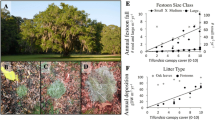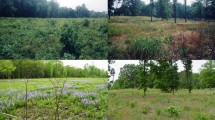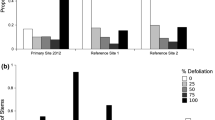Abstract
Climate change-induced droughts have contributed to large-scale die-offs of dominant tree species throughout much of the southwestern United States. These mortality events provide ecologists with the opportunity to determine whether afterlife effects associated with the die-off occur and the potential implications for future ecosystem changes. We studied both the afterlife and interaction effects of condition (dead trees, living trees, and open areas) on understory vegetation in a Juniperus monosperma woodland of northern Arizona 7 years after a major mortality event. Five major findings resulted: (1) there was a positive afterlife effect on understory plants, in which vegetation under dead junipers contained almost double the amount of cover; (2) the competitive effect on understory plants was exemplified by a 1.3 times greater cover and 1.6 additional species in open areas compared to under living junipers; (3) plant community composition significantly differed by aspect and condition; (4) the highly invasive cheatgrass (Bromus tectorum) was 1.5 times greater under dead junipers compared to live junipers; and (5) litter depth and light availability were negatively and positively correlated with plant cover, respectively, but weakly correlated with afterlife effects. Our results indicate that mortality events can promote changes in understory vegetation through afterlife effects. In ecosystems where foundation species suffer high rates of mortality, changes in plant population dynamics and ecosystem function may promote an altered trajectory in community composition with the potential to increase the presence of invasive species. Continued species die-offs associated with climate change-induced drought may contribute to an increased occurrence and legacy of afterlife effects.


Similar content being viewed by others
References
Armas C, Ordiales R, Pugnaire FI (2004) Measuring plant interactions: a new comparative index. Ecology 85:2682–2686
Bates JD, Miller RF, Svejcar TJ (2000) Understory dynamics in cut and uncut western juniper woodlands. J Range Manag 53:119–126
Bradley BA, Houghton RA, Mustard JF, Hamburg SP (2006) Invasive grass reduces aboveground carbon stocks in shrublands of the western US. Glob Chang Biol 12:1815–1822
Breshears DD (2006) The grassland-forest continuum: trends in ecosystem properties for woody plant mosaics? Front Ecol Environ 4:96–104
Breshears DD, Cobb NS, Rich PM, Price KP, Allen CD et al (2005) Regional vegetation die-off in response to global-change-type drought. Proc Natl Acad Sci USA 102:15144–15148
Brockway DG, Gatewood RG, Paris RB (2002) Restoring grassland savannas from degraded pinyon-juniper woodlands: effects of mechanical overstory reduction and slash treatment alternatives. J Environ Manag 64:179–197
Callaway RM (1997) Positive interactions in plant communities and the individualistic continuum concept. Oecologia 112:143–149
Callaway RM, Walker LR (1997) Competition and facilitation: a synthetic approach to interactions in plant communities. Ecology 78:1958–1965
Chambers JC, Vander Wall SB, Schupp EW (1999) Seed and seedling ecology of piñon and juniper species in the pygmy woodlands of North America. Bot Rev 65:2–32
D’Antonio CD, Vitousek PM (1992) Biological invasions by exotic grasses: the grass/fire cycle and global change. Annu Rev Ecol Syst 23:63–87
Davis MA, Wrage KJ, Reich PB (1998) Competition between tree seedlings and herbaceous vegetation: support for a theory of resource supply and demand. J Ecol 86:652–661
Davis MA, Grime JP, Thompson K (2000) Fluctuating resources in plant communities: a general theory of invasibility. J Ecol 88:528–534
Dayton PK (1972) Toward an understanding of community resilience and the potential effects of enrichments to the benthos at McMurdo Sound, Antarctica. In: Parker BC (ed) Proceedings of the colloquium on conservation problems in Antarctica. Allen Press, Lawrence
Dye KL II, Ueckert DN, Whisenant SG (1995) Redberry juniper–herbaceous understory interactions. J Range Manag 48:100–107
Ellison AM, Bank MS, Clinton BD, Colburn EA, Elliott K et al (2005) Loss of foundation species: consequences for the structure and dynamics of forested ecosystems. Front Ecol Environ 9:479–486
Evans LM, Allen GJ, Shuster SM, Woolbright SA, Whitham TG (2008) Tree hybridization and genotypic variation drive cryptic speciation of a specialist mite herbivore. Evolution 62:3027–3040
Findlay S, Carreiro M, Krischik V, Jones CG (1996) Effects of damage to living plants on leaf litter quality. Ecol Appl 6:269–275
Franks SJ, Sim S, Weis AE (2007) Rapid evolution of flowering time by an annual plant in response to a climate fluctuation. Proc Natl Acad Sci USA 104:1278–1282
Gitlin AR, Sthultz CM, Bowker MA, Stumpf S, Paxton KL et al (2006) Mortality gradients within and among dominant plant populations as barometers of ecosystem change during extreme drought. Conserv Biol 20:1477–1486
Grime JP (1974) Vegetation classification by reference to strategies. Nature 250:26–31
House JI, Archer S, Breshears DD, Scholes RJ et al (2003) Conundrums in mixed woody–herbaceous plant systems. J Biogeogr 30:1763–1777
Humphrey LD, Schupp EW (2004) Competition as a barrier to establishment of a native perennial grass species (Elymus elymoides) in alien annual grass (Bromus tectorum) communities. J Arid Environ 58:405–422
Kuske CR, Ticknor LO, Busch JD, Gehring CA, Whitham TG (2003) The pinyon rhizosphere, plant stress, and herbivory affect the abundance of microbial decomposers in soils. Microb Ecol 45:340–352
Martens SN, Breshears DD, Meyer CW (2000) Spatial distributions of understory light along the grassland/forest continuum: effects of cover, height, and spatial pattern of tree canopies. Ecol Model 126:79–93
McCune B, Mefford MJ (1999) PC-ORD. Multivariate analysis of ecological data. Version 5.0. MjM Software, Gleneden Beach
McDowell NM, Pockman WT, Allen C, Breshears DD, Cobb N et al (2008) Mechanisms of plant survival and mortality to drought: why do some plants survive while others succumb to drought? New Phytol 178:719–739
Michalet R, Rolland C, Joud D, Gafta D, Callaway RM (2003) Associations between canopy and understory species increase along a rainshadow gradient in the Alps: habitat heterogeneity or facilitation? Plant Ecol 165:145–160
Mueller RC, Scudder CM, Porter ME, Trotter RT III, Gehring CA, Whitham TG (2005) Differential tree mortality in response to severe drought: evidence for long-term vegetation shifts. J Ecol 93:1085–1093
Nilsson M, Wardle DA, Dahlberg A (1999) Effects of plant litter species composition and diversity on the boreal forest plant–soil system. Oikos 86:16–26
Ogle K, Whitham TG, Cobb NS (2000) Tree-ring variation in pinyon predicts likelihood of death following severe drought. Ecology 81:3237–3243
Padien DJ, Lajtha K (1992) Plant spatial pattern and nutrient distribution in pinyon-juniper woodlands along an elevational gradient in northern New Mexico. Int J Plant Sci 153:425–433
Pagès JP, Michalet R (2006) Contrasted responses of two understorey species to direct and indirect effects of a canopy gap. Plant Ecol 187:179–187
Prevéy JS, Germino MJ, Huntly NJ, Inouye RS (2010) Exotic plants increase and native plants decrease with loss of foundation species in sagebrush steppe. Plant Ecol 207:39–51
Rehfeldt GE, Crookston NL, Warwell MV, Evans JS (2006) Empirical analyses of plant–climate relationships for the western United States. Int J Plant Sci 167:1123–1150
Risser PG (1995) The status of the science of examining ecotones. Bioscience 45:318–325
SAS Institute Inc (2007) JMP, version 7. SAS Institute, Cary
Schweitzer JA, Bailey JK, Hart SC, Whitham TG (2005) Nonadditive effects of mixing cottonwood genotypes on litter decomposition and nutrient dynamics. Ecology 86:2834–2840
Seager R, Ting M, Held I, Kushnir Y, Lu J, Vecchi G, Huang H-P, Harnik N, Leetmaa A, Lau NC, Li C, Velez J, Naik N (2007) Model projections of an imminent transition to a more arid climate in southwestern North America. Science 316:1181–1184
Sperry LJ, Belnap J, Evens RD (2006) Bromus tectorum invasion alters nitrogen dynamics in an undisturbed arid grassland ecosystem. Ecology 87:603–615
Sthultz CM, Gehring CA, Whitham TG (2009) Deadly combination of genes and drought: Increased mortality of herbivore-resistant trees in a foundation species. Glob Chang Biol 15:1949–1961
Taylor DR, Aarssen LW, Loehle C (1990) On the relationship between r/K selection and environmental carrying capacity: a new habitat templet for plant life-history strategies. Oikos 58:239–250
Teder T, Tammaru T (2002) Cascading effects of variation in plant vigour on the relative performance of insect herbivores and their parasitoids. Ecol Entomol 27:94–104
Tilman GD (1994) Competition and biodiversity in spatially structured habitats. Ecology 75:2–16
van Mantgem PJ, Stephenson NL, Byrne JC, Daniels LD, Franklin JF, Fulé PZ, Harmon ME, Larson AJ, Smith JM, Taylor AH, Veblen TT (2009) Widespread increase of tree mortality rates in the western United States. Science 323:521–524
Wayman RB, North M (2007) Initial response of a mixed-conifer understory plant community to burning and thinning restoration treatments. For Ecol Manag 239:32–44
West NE (1984) Successional patterns and productivity potentials of pinyon-juniper ecosystems. In: Developing strategies for range management: a report. Westview Press, Boulder, pp 1301–1332
Acknowledgments
The authors would like to dedicate this article to our co-author, B.L. Cardall, and his family. C. West graciously provided assistance with field data collection. Two anonymous reviewers provided constructive feedback that improved the manuscript.
Author information
Authors and Affiliations
Corresponding author
Rights and permissions
About this article
Cite this article
Kane, J.M., Meinhardt, K.A., Chang, T. et al. Drought-induced mortality of a foundation species (Juniperus monosperma) promotes positive afterlife effects in understory vegetation. Plant Ecol 212, 733–741 (2011). https://doi.org/10.1007/s11258-010-9859-x
Received:
Accepted:
Published:
Issue Date:
DOI: https://doi.org/10.1007/s11258-010-9859-x




